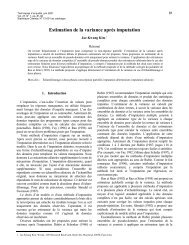Gender Differences in Police-reported Violent Crime in Canada, 2008
Gender Differences in Police-reported Violent Crime in Canada, 2008
Gender Differences in Police-reported Violent Crime in Canada, 2008
Create successful ePaper yourself
Turn your PDF publications into a flip-book with our unique Google optimized e-Paper software.
Canadian Centre for Justice Statistics Profile Series<br />
Sexual assaults<br />
<strong>Police</strong>-<strong>reported</strong> sexual assault rate more than 10 times higher for female victims compared to<br />
males<br />
In <strong>2008</strong>, the rate of police-<strong>reported</strong> sexual assault aga<strong>in</strong>st females (68 per 100,000 population) was more<br />
than 10 times the rate for males (6 per 100,000 population), with females account<strong>in</strong>g for 92% of sexual assault<br />
victims <strong>in</strong> <strong>Canada</strong>. Overall rates of sexual assaults for female victims are significantly greater than males across<br />
each age group (Table 1, Table 2).<br />
It is worth not<strong>in</strong>g that sexual assaults go un<strong>reported</strong> to police more often than other types of violent offences,<br />
regardless of whether the victim is female or male. Accord<strong>in</strong>g to the 2004 GSS on Victimization, about 8% of sexual<br />
assaults were <strong>reported</strong> to police, compared to about 40% of physical assaults and about half of robberies (Brennan<br />
and Taylor-Butts, <strong>2008</strong>). Furthermore, male and female victims showed no significant difference <strong>in</strong> their likelihood<br />
of report<strong>in</strong>g sexual assaults to police.<br />
More than one-quarter of female victims of sexual assault suffered a physical <strong>in</strong>jury<br />
Regardless of whether the victim was male or female, physical force was used aga<strong>in</strong>st the victim <strong>in</strong> 95% of sexual<br />
assaults. While two-thirds (60%) of police-<strong>reported</strong> sexual assaults aga<strong>in</strong>st females did not result <strong>in</strong> a physical<br />
<strong>in</strong>jury, 24% resulted <strong>in</strong> m<strong>in</strong>or physical <strong>in</strong>juries requir<strong>in</strong>g some first aid but no professional medical treatment (Table<br />
5, Table 6).<br />
Higher proportion of sexual assaults aga<strong>in</strong>st male victims occur <strong>in</strong> <strong>in</strong>stitutional sett<strong>in</strong>gs<br />
Sexual assaults most often occurred <strong>in</strong> residential locations. Nearly 2 out of 3 (59%) sexual assault victimizations<br />
of females occurred <strong>in</strong> a private residence as did 48% of sexual assaults aga<strong>in</strong>st males. However, for male victims<br />
of sexual assault, the proportion of those victimized <strong>in</strong> an <strong>in</strong>stitutional sett<strong>in</strong>g (16%) such as a school, university or<br />
college or other non-commercial or corporate place was more than 2.5 times greater than the proportion of females<br />
sexually assaulted <strong>in</strong> this type of location (Table 5, Table 6).<br />
Accused <strong>in</strong> <strong>in</strong>cidents of sexual assaults aga<strong>in</strong>st male and female are often known to the victim<br />
In nearly half of police-<strong>reported</strong> sexual assaults aga<strong>in</strong>st both male (47%) and female (44%) victims, the accused<br />
was someone known to the victim (e.g., friend, acqua<strong>in</strong>tance, or current/former dat<strong>in</strong>g partner) but was not a family<br />
member. Strangers were the perpetrators <strong>in</strong> one-quarter of all police-<strong>reported</strong> sexual assaults committed aga<strong>in</strong>st<br />
men (19%) and women (24%) (Table 5, Table 6).<br />
There were, however, some notable gender-based differences <strong>in</strong> the relationship between the victim and the accused<br />
<strong>in</strong> cases of sexual assaults com<strong>in</strong>g to the attention of police. For example, women were more likely than men to<br />
have been sexually assaulted by a current or former spouse. In <strong>2008</strong>, the accused was a current or former spouse<br />
<strong>in</strong> 8% of police-<strong>reported</strong> sexual assaults aga<strong>in</strong>st females compared to 1% of sexual assaults where the victim was<br />
male. As well, a current or former dat<strong>in</strong>g partner was identified as the accused more often <strong>in</strong> sexual assaults aga<strong>in</strong>st<br />
women (7%) compared to men (1%). Male victims of sexual assault, however, were more often victimized by family<br />
members other than spouses or ex-spouses and by friends and acqua<strong>in</strong>tances, <strong>in</strong> comparison to female sexual<br />
assault victims (Table 5, Table 6).<br />
10 Statistics <strong>Canada</strong> – Catalogue no. 85F0033M, no. 24
















